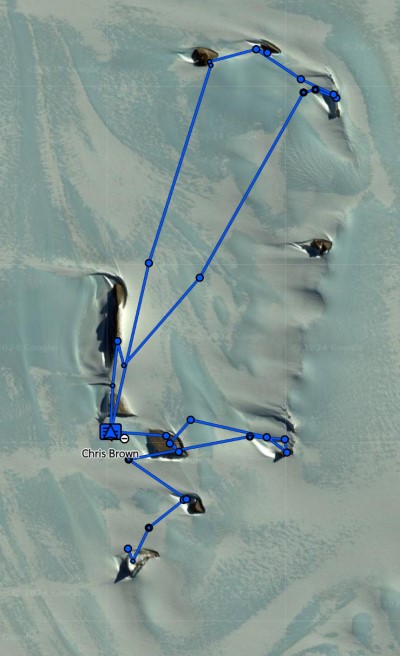Nine Nunataks
Nunataks are exposed, rocky peaks or ridges that protrude through ice or snow cover in antarctica. You can think of them as the tops of mountains sticking out of the ice.
Nunataks are composed of hard, resistant rock that can withstand the pressure of the surrounding ice. The exposed rock can vary in composition, including granite, schist, and other types of bedrock. They have been shaped by wind, glacial erosion and deposition. Glaciers flow around and over nunataks, carving out valleys and cirques, and depositing moraines around their bases.
The wind rips around Nunataks and forms a type of ‘halo’ or dip between the ice and the base of the rock.

Antarctic Nunatak
Despite their harsh environments, nunataks can provide habitat for a variety of plants and animals adapted to polar conditions. Mosses, lichens, and algae may grow on exposed rock surfaces, and birds such as Snow Petrels and other animals may nest or forage in the vicinity.
On my first expedition to the Southern Pole of Inaccessibility – the one that failed and saw us stranded in Antarctica for 28 days – we spent time climbing the nearby Nunataks, and ice climbing the surrounds. When we finally, finally managed to get a flight out, I took some time to look down on the area that had been our home for a month. From the skies I counted nine nearby Nunataks and formed an idea that if we ever returned, I’d try to climb them all.
Roll on one year and we made our successful trip to the Antarctic Pole of Inaccessibility right at the start of our expedition window. That left us with some spare time before being exfiltrated from the wolf’s fang base.
It was time to put my idea into practice: could we climb Nine Nunataks in under Nine hours?

Our High Mountain Guide for the day
We spent a day forming the plan with two qualified Mountain Guides. Jean Paul would come with us, and Neil Brody would monitor our progress and safety from camp. We planned to use an Arctic Truck to get between Nunataks.
On the day, the weather was kind to us, with little wind and reasonable, minus 20ish, temperatures. We had deliberately picked three of the hardest in our first four to take advantage of our glycogen supplies and gradually getting easier, apart from the penultimate Nunatak which was further removed from camp.









The climbing itself was fairly straight forward and involved more scrambling than technical work. Perhaps the most dangerous part was the approach to each Nunatak where crevices were more likely to occur. Even the penultimate climb was easier than expected; between 2022 and 2023 the ice had moved in a way to make the approach much gentler.
Just 8 hours and 12 minutes after leaving our Arctic Truck at the first Nunatak, we summited outcrop number nine.
Mission accomplished!

Garmin record of the Nine Nunataks Adventure
